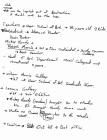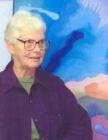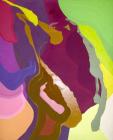1
Eleanor Mackey, who goes by the name of Elly, was born in 1932 in Port Colborne, Ontario, as Eleanor Dorothy Johnston. She was the youngest of seven children and was raised in Port Colborne.She attended Toronto Teachers' College from 1962 to 1963. In 1963, she moved to Oshawa, Ontario, where she was an art teacher and head of the art department at the Oneil Collegiate and Vocational Institute. In c. 1965, she and her husband, Allan Doug Mackey (who goes by the name of Doug), moved to Toronto, where Eleanor attended the New School of Art. The school was started in 1965 by Hockley Valley School and located in several locations over the years in the Annex district. She studied under Robert Markle, Dennis Burton, Gordon Rayner, Graham Coughtry, Robert Hedrick and Michael Handy, and Ken Lywood. She was a tour guide at the Art Gallery of Ontario from 1969 to 1970. Eleanor and Doug then moved to Powassan, Ontario on the edge of Algonquin Park, where they currently reside, to raise their five children.
From 1978 to 1979, she delivered lectures on Canadian painting at Laurentian University in Sudbury, Ontario, and conducted a series of workshops at Laurentian University Museum and Art Centre, organized by the director at the latter, Pamela Kreuger.
In the planning of a two-person exhibition at the W. K. P. Kennedy Gallery with British Columbia artist, Sara McIntosh, she spent a month visiting her studio in Langley in March 2006. She was a guest teacher in several of Sara's classes at the Surrey Gallery.
Solo exhibitions of her work have been held at Isaacs Gallery (Toronto, Ontario, 1968), Laurentian Museum & Art Centre (Sudbury, Ontario, 1979), The Powassan and District Union Public Library (2002), Art in Public Places (Capitol Centre, North Bay, Ontario, 2003), Renee's Gallery (South River, Ontario, 2004) and White Water Gallery (North Bay, Ontario, 2005).
She received grants for Creative Artists in the Schools in the early and mid-1970s.
(The biographical information featured here was written in consultation with the artist in 2006.)
Interview:
Q: Did being the youngest of seven affect how you approached your life and/or art?
A: I have vivid memories of myself as a four or five year old being asked to show visitors and family how I could draw pictures of them. I had talent and it was encouraged. Not one of the others displayed this particular ability. I felt special and differentiated. It wasn't so much being the youngest of seven that influenced my life but the need to escape. I liked being alone, away from the inevitable noise and confusion of a large household. I was constantly sequestering myself away in corners and large closets and withdrawing into an imaginative world with my reading and drawing. I was also considered special because I consistently got the highest marks at school. This had not been the case with the older siblings (except perhaps with the two eldest who, at that time, were already away at Normal School (Mary) and in the Seminary (Joseph), I grew up feeling I had a responsibility to nurture my God-given gifts and to share them. But truthfully I was inwardly driven--I needed to do it for myself.
Q: Do you feel that raising your children has changed how you create?
A: Raising the children has definitely changed the way I create and the way we live! I give a lot of credit to my situation in the sixties and seventies with the evolution into my kind of abstraction. I had four children at the time, meaning a lot of interruptions into my personal space--no long hours [where I was] able to focus on ideas and explorations--My own personal style--or "voice" developed of layering modulating curvilinear interpenetrating transparent forms. Each layer took time to dry and this time I spent on the family responsibilities and activities.
We also used household space differently than our neighbours. Because I needed floor-space to lie out the canvas in order to layer on the transparent washes (diluted acrylic) and I didn't have a separate studio, our living spaces became workspaces both for myself and the children.
Q: Did working with Sara McIntosh in the Conversations in Colour exhibition challenge you to think differently when you approached your art?
A: The idea of a "conversation" stimulated us to leave our egos at the door and get into each other's head and into each other's lives and relationships. The 40-year difference in age and experience was revealing. There was no problem relating to each other. I believe that's because of strong feelings about the activity of creating. We are both passionate about lyrical colour-field abstractions even though we approach our work with different methods, techniques and images.
The biggest challenge was our decision to collaborate alternately on the same paintings. We needed to focus on somehow integrating two different styles and making it work in the completed painting. We included four of these in the exhibition and we are still working on a few more.
Q: How has your artwork changed since the sixties?
A: In the sixties I worked on raw canvas with large fields of interpenetrating transparent stains. It was in those years that I developed my unique "voice" of modulating curve patterns across the surface creating ambiguous depths of elegant coloured veils. These would have been called minimalist because of a limited colour range and the concept of transforming the curved edges gradually away from the straight edge of the canvas.
Since then, while still maintaining my unique voice of progressively modulating curves integrated within the rectangle, I have become more passionate about the "reality" of the paint itself. Tactility is very exciting to me now. The various feelings generated by moving gradually from a stain into a more opaque and more intense colour; by moving gradually into an impasto and then into a sheen that reflects light. Then the move into incredibly elegant and playful poured curvilinear forms. I am also, in this way, exploring more complex colour relationships
Q: What is your artwork about and what influences you?
A: My paintings are about the joy and satisfaction I feel while [making art]. I sometimes call the paintings 'painterly metaphors'. I've also said that I feel like I'm dancing with the paint (the canvas is worked from all sides flat on the floor). I like to share this experience with the viewers. The paintings speak for themselves!
Q: What is the process you go through from the beginning to the end of a painting?
A: This is very difficult as practically each painting involves a slightly different process. Also since the last exhibit (September, 2006), I have been changing more drastically. I will describe the pre-September work:
Spontaneously, I choose a size of raw canvas that I feel, at the moment that I can deal with. It is laid out on the floor. I mix up a pot of diluted acrylic. The colour could be one I have been considering for a while or it can be completely a spontaneous decision. That is what is so exciting about painting for me. I have no preconceived ideas about controlling what happens on that surface. There is a dialogue going on between what I feel the paint wants to do and what I feel I can do to help it look logical and beautiful.
The first layers are poured unto the canvas and then using the chance flows and rivulets as somewhat of a guide, I form an initial curve pattern that is somewhat integrated with the straight edges of the rectangle. As I build up more layers of paint, the curved edges are modulated slowly as the colour intensity develops and curvilinear forms begin to evolve. With the use of different mediums--matte, gloss, gel--I can modulate the textures along with the colours and the curved edges. All the while I am not pushing any preconceived image but am coaxing the forms to work out their own logic. I love surprises that work!
Before the painting is complete but after I have a pretty good idea of it working out, I stretch it. Then the deeper and heavier textured bits can be applied--the elegant and playful forms that seem to swim or dance in the curved layers.
Q: Other than your artwork, what other interests do you have?
A: Reading, mostly literary novels and good mystery novels--I like to keep up with the latest ideas in Philosophy, Science and Math. I like cooking for just my husband and me, and spending time with the children and grandchildren.
Q: Could you tell us more about your paintings?
A: I am not a conceptual artist. These are lyrical abstractions and are about feelings--tactile and visual. The paintings speak for themselves.
(Interview with Kathryn Copeland in December, 2006).
5
Eleanor Mackey, Excerpt from interview notes by Christopher Régimbal for W. K. P. Kennedy catalogue2006



